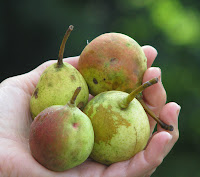Elegance doesn’t generally wow me in the garden (or in architecture or home furnishings); lack of elegance often does. A most inelegant, cheerful flower is now in bloom. The plant is hibiscus, not the tropical one with glossy leaves and coaster-sized flowers, but the hardy, herbaceous perennial ones now sporting dinnerplate-size, red-bordering-on-hot-pink blossoms. What fun!

Looking at my plant more closely, I see that chewed up leaves are making the plants look . . . okay, perhaps a bit too inelegant. The culprit is the hibiscus sawfly, which looks something like a housefly as an adult, except the body section right behind its head is orange-brown in color. The real culprits, though, are the young, the small green caterpillars, who do the feeding.
So here’s my reminder, for next year, to pick the caterpillars off the plants early in the growing season. The caterpillars are also susceptible to most pesticides, which could be a last resort option. The moms keep laying eggs during the growing season so handpicking or spraying has to continue throughout the season. I’ll also keep an eye out for the caterpillars on my hollyhocks, of which I have 20 seedlings that will be ready to plant out next spring.
Thankfully the sawfly doesn’t attack some other important members of the hibiscus (mallow) family, such as okra, rose-of-sharon, and the tropical hibiscus I rescued from the Smith & Hawkens dumpster a few weeks ago.
**************************************************
Incessant rain. Never-ending rain. Day after day of rain. And with it comes mosquitoes and weeds. If there were going to be one theme for this year’s garden, it would be “weeds” (particularly troublesome for the author—me -- of a book boldly titled Weedless Gardening).
I do have weeds pretty much under control. In previous years that control, using techniques I describe in my book, required perhaps 5 minutes each week weed. Control this summer has required perhaps a half an hour per week.
Each season brings changes in the makeup of garden weeds, depending on the season’s weather patterns and changes, over time, in soil. This year’s most prominent weed is woodsorrel, a weed with yellow flowers and with leaves that resemble those of clover. There are two closely related species, an upright, bright green species, common yellow woodsorrel (Oxalis stricta), and a creeping form, called – you guessed it – creeping yellow woodsorrel (O. corniculata).
Both wood sorrels are having a field day in my garden this year. The upright woodsorrel is easy and very satisfying to pull out. I just grab the top and the whole plant pops out of the ground. The creeping woodsorrel is more problematic because roots sprout from the stems as they creep along the ground and the purplish brown leaves make the plant hard to see against the soil.
I’m careful and diligent about grubbing out woodsorrels because seedpods of both species readily pop open to actually shoot their seeds. I envelop as much of each plant in my hand as much as possible then keep my fist closed around what I’ve grabbed until I’ve shoved the offender down inside my weed bucket.
As with other plants named sorrel, woodsorrels are edible, with a lemony flavor. I don’t like them that much.
**************************************************
All is not caterpillars, weeds, and other pests in the garden. This week the garden offered up a bumper crop of hardy kiwifruits (Actinidia kolomikta), a cold-hardy relative of our markets’ fuzzy kiwifruits, which are not cold-hardy here. Hardy kiwifruits have the same emerald green flesh as their cold-tender cousins, but the fruits are grape-sized and, with their smooth, edible skin, can be popped whole into your mouth. The flavor is also sweeter and more aromatic than the fuzzies.

Now is not the first time this year that hardy kiwifruits have wowed me. The vine itself is quite a beauty with variegated, luminescent leaves that are especially so all through spring. The leaves are brushed with areas of silvery pink, sometimes leaving circles of green that seem to have been painted on with an artist’s brush (something I jokingly assert to visiting children).
Hardy kiwifruit is an uncommon fruit that’s ideal excellent for “luscious landscaping,” that is, the use of fruit plants a for their beauty and their bounty. Besides beauty and good flavor, the only care the plant needs is annual pruning. If you are willing to sacrifice some yield of fruit and convenience in harvesting, the plants hardly even need that.

You do need at least two plants to reap a harvest of berries, one female for fruit and one male to provide pollen so that the female (or up to 8 females) can fruit. The males aren’t useless except for their pollen, though. They have the showiest leaves.
************************************************




